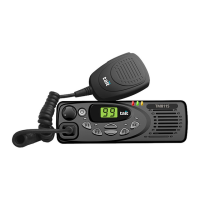324 Transmitter Fault Finding (25W) TM8100/TM8200 Service Manual
© Tait Electronics Limited June 2006
Frequency Bands Where test procedures or figures differ according to the frequency band of
the radio, the frequency band is given in brackets. The frequency band may
be referred to as either ‘VHF’ (very high frequency) or ‘UHF’ (ultra high
frequency) or identified by the frequency sub-band, such as ‘B1’ or ‘H7’.
For example:
A definition of frequency bands is given in “Defining Frequency Bands” on
page 126.
Emergency
Frequencies
The following frequency ranges are reserved worldwide for use as maritime
emergency frequencies or by distress beacons:
■ B1 band: 156.8MHz ± 375kHz
■ D1 band: 243MHz ± 5kHz
■ H5 band: 406.0 to 406.1MHz.
Do not
program the radio with any frequency in the above ranges.
Can Removal There are five cans shielding the bulk of the transmitter circuitry:
■ PAD TOP
■ PAF TOP
■ DIRC TOP
■ PIN TOP
■ LPF TOP.
To remove any can, first remove the board. In the case of the
PAD TOP and
PAF TOP cans, first detach the heat-transfer block from the board. Secure the
block again after removing the cans. Follow the procedures given in
“Disassembly and Reassembly” on page 129.
Can Replacement Replace all cans that have been removed only after repairing the board.
This applies to the A4, B1, C0, D1, H5 and H6 bands. For certain other
bands the transmitter will not operate correctly unless all the cans are fitted.
RF output power: > 35W
current: < 8A (VHF), < 9A (UHF)
Table 12.2 Lowest, centre and highest frequencies in MHz
Band
Lowest
frequency
Centre
frequency
Highest
frequency
A4
B1
C0
D1
H5
H6
66
136
174
216
400
450
77
155
199.5
241
435
490
88
174
225
266
470
530

